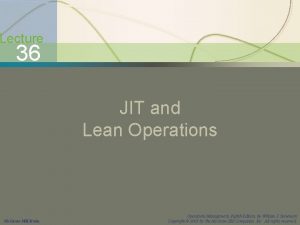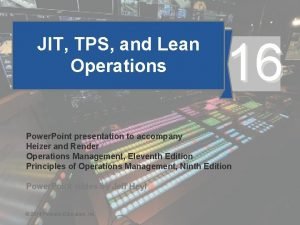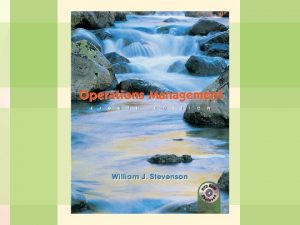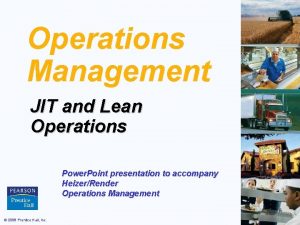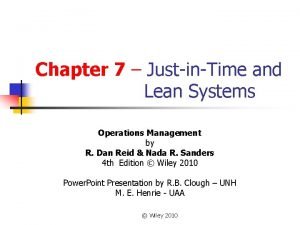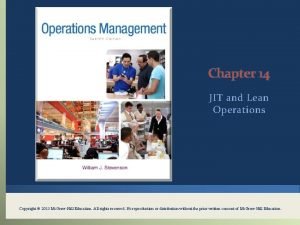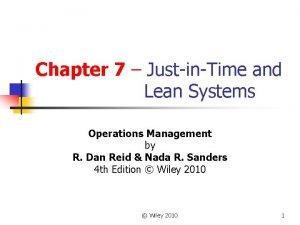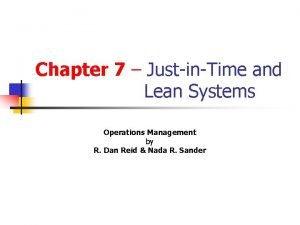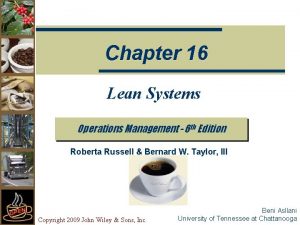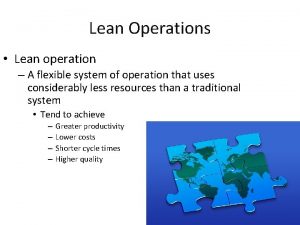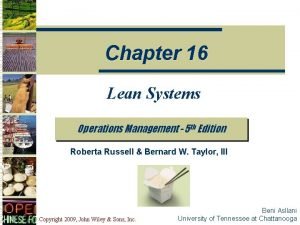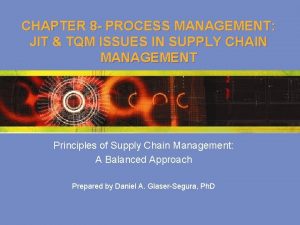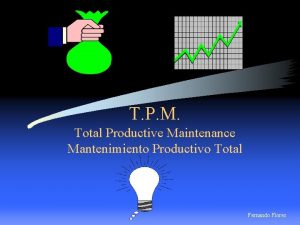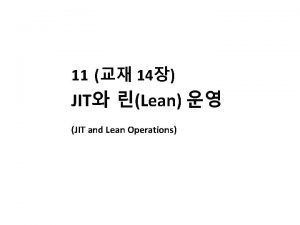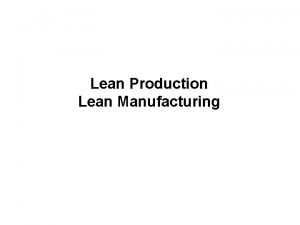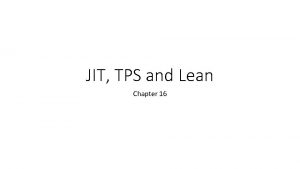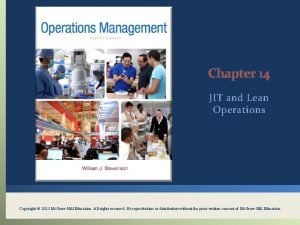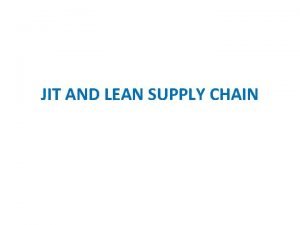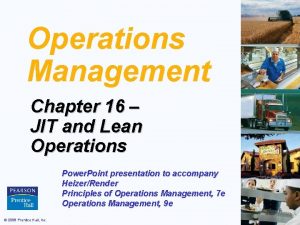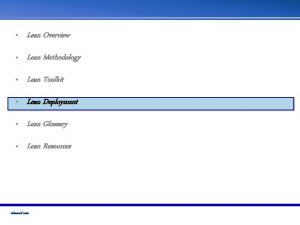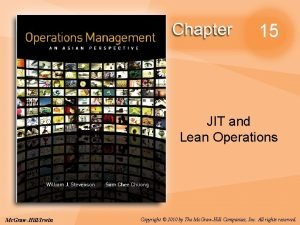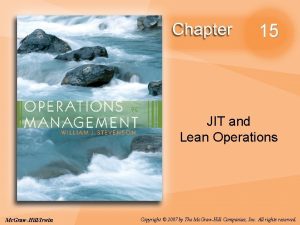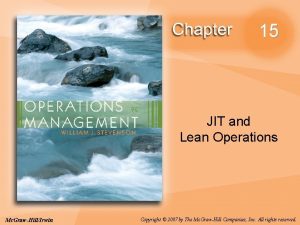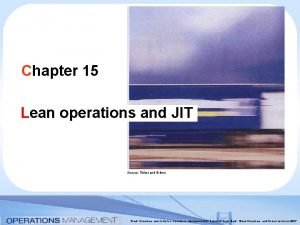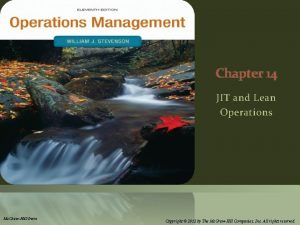Chapter 14 JIT and Lean Operations Copyright 2015















- Slides: 15

Chapter 14 JIT and Lean Operations Copyright © 2015 Mc. Graw-Hill Education. All rights reserved. No reproduction or distribution without the prior written consent of Mc. Graw-Hill Education.

Chapter 14: Learning Objectives You should be able to: LO 14. 1 LO 14. 2 LO 14. 3 LO 14. 4 LO 14. 5 LO 14. 6 Explain the terms lean operations and JIT Describe the main characteristics of lean systems List the five principles of the way lean system function List some of the benefits and some of the risks of lean operations Describe the Toyota Production System (TPS) List the three goals of a lean system and explain its importance of each LO 14. 7 List the eight wastes according to lean philosophy LO 14. 8 Identify and briefly discuss the four building blocks of a lean production system LO 14. 9 Describe key lean improvement tools LO 14. 10 Outline considerations for successful conversion from a traditional system to a lean system LO 14. 11 Describe some of the obstacles to lean success 14 -2

Lean Operations �Lean operation � A flexible system of operation that uses considerably less resources than a traditional system �Tend to achieve Greater productivity Lower costs Shorter cycle times Higher quality �Just-in-Time � A highly coordinated processing system in which goods move through the system, and services are performed, just as they are needed LO 14. 1 14 -3

Lean System Characteristics � A number of characteristics are commonly found in lean systems: � Waste reduction � Continuous improvement � Use of teams � Work cells � Visual controls � High quality � Minimal inventory � Output only to match demand � Quick changeovers � Small lot sizes � Lean culture LO 14. 2 14 -4

Lean System Principles �Five principles embody the way lean systems function: 1. 2. 3. 4. 5. LO 14. 3 Identify customer values Focus on processes that create value Eliminate waste to create “flow” Produce only according to customer demand Strive for perfection 14 -5

Benefits & Risks of Lean Systems �Key Benefits � Reduced waste � Lower costs � Increased quality � Reduced cycle time � Increased flexibility � Increased productivity �Critical Risks � Increased stress on workers � Fewer resources available if problems occur � Supply chain disruptions can halt operations LO 14. 4 14 -6

Lean Operations: The Beginning � Lean operations began as lean manufacturing, also known as JIT in the mid-1900 s � Developed by Taiichi Ohno and Shigeo Ohno of Toyota � Focus was on eliminating all waste from every aspect of the process �Waste is viewed as anything that interferes with, or does not add value to, the process of producing automobiles LO 14. 5 14 -7

Lean: Supporting Goals �The degree to which lean’s ultimate goal is achieved depends upon how well its supporting goals are achieved: Eliminate disruptions 2. Make the system flexible 3. Eliminate waste, especially excess inventory 1. LO 14. 6 14 -8

Waste � Represents unproductive resources � Eight sources of waste in lean systems: 1. Excess inventory 2. Overproduction 3. Waiting time 4. Unnecessary transporting 5. Processing waste 6. Inefficient work methods 7. Product defects 8. Underused people LO 14. 7 14 -9

Building Blocks: Product Design �Four elements of product design important for lean systems: Standard parts 2. Modular design 3. Highly capable systems with quality built in 4. Concurrent engineering 1. LO 14. 8 14 -10

Building Blocks: Personnel/Organizational �Five personnel/organizational elements that are important for lean systems: � Workers as assets � Cross-trained workers � Continuous improvement � Cost accounting � Leadership/project management LO 14. 8 14 -11

Building Blocks: MPC � Seven elements of manufacturing planning and control (MPC) are particularly important for lean system: 1. 2. 3. 4. 5. 6. 7. LO 14. 8 Level loading Pull systems Visual systems Limited work-in-process (WIP) Close vendor relationships Reduced transaction processing Preventive maintenance and housekeeping 14 -12

Lean Tools: Value Stream Mapping �Value stream mapping � A visual tool to systematically examine the flows of materials and information �Its purpose is to help identify waste and opportunities for improvement �Data collected: Times Distances traveled Mistakes Inefficient work methods Waiting times Information flows LO 14. 9 14 -13

Transitioning to Lean Systems 1. Make sure top management is committed and that they know what will be required 2. Decide which parts will need the most effort to convert 3. Obtain support and cooperation of workers 4. Begin by trying to reduce setup times while maintaining the current system 5. Gradually convert operations, begin at the end and work backwards 6. Convert suppliers to JIT 7. Prepare for obstacles LO 14. 10 14 -14

Obstacles to Conversion 1. Management may not be fully committed or willing to devote the necessary resources to conversion 2. Workers/management may not be cooperative 3. It can be difficult to change the organizational culture to one consistent with the lean philosophy 4. Suppliers may resist LO 14. 11 14 -15
 Jit lean manufacturing
Jit lean manufacturing Jit scheduling tactics
Jit scheduling tactics Jit operations management
Jit operations management Jit inventory
Jit inventory Lean operations and systems
Lean operations and systems Copyright 2015 all rights reserved
Copyright 2015 all rights reserved Copyright © 2015 all rights reserved
Copyright © 2015 all rights reserved The four building blocks of lean operations are
The four building blocks of lean operations are Lean systems operations management
Lean systems operations management Lean systems operations management
Lean systems operations management Lean systems operations management
Lean systems operations management In the lean philosophy, the ideal lot size is:
In the lean philosophy, the ideal lot size is: Lean systems operations management
Lean systems operations management Jit and tqm issues in supply chain management
Jit and tqm issues in supply chain management Warp processing
Warp processing Estructura del tpm
Estructura del tpm
